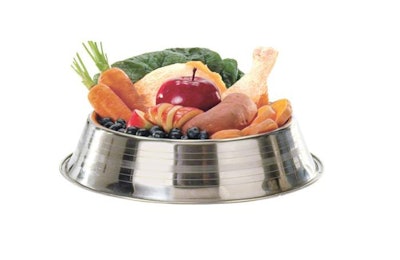
The dictionary includes multiple definitions for “fresh.” Perhaps the one that best applies to pet food is this: “Not preserved, as by canning, smoking or freezing.” Yet as a market category, fresh pet food is still not well-defined, established or tracked — is that about to change?
One expert market observer believes so. David Lummis, lead pet market analyst for Packaged Facts, wrote recently on PetProductNews.com that “superpremium pet food’s future is fresh.” Citing results of a survey conducted by his company earlier this year, showing that 74 percent of U.S. food shoppers chose “fresh” as the top appealing human food characteristic by far, he posited that’s one key reason we’re seeing a growing number of pet food brands offer fresh products.
The Packaged Facts data is corroborated by Mintel, whose 2016 research showed 76 percent of U.S. consumers chose freshness as a priority for food shopping, though that was second to taste at 83 percent and only a little ahead of cost at 72 percent.
Specific to pet food, some consumer behavior data may shed further light: another Packaged Facts survey from 2017 indicated that 32 percent of U.S. dog owners and 18 percent of cat owners mix human foods or food products into their pets’ primary pet food diets. That compared very favorably with pet owners mixing commercial products, like gravies, mixers and toppers, into their pets’ food (22 percent for both dog and cat owners).
What exactly is fresh pet food?
Yet here’s a possible sticking point: does everyone know or agree on what fresh pet food is, or how it should be defined and categorized? Does it encompass any products not processed via traditional methods like extrusion for kibble or retort for wet pet foods? That would include small but fast-growing categories such as raw frozen — with sales increasing in the U.S. pet specialty channel by about 17 percent a year, according to GfK — and freeze dried — growing at a healthy clip of 34 percent. Notwithstanding the Packaged Facts data for commercial mixers and toppers, GfK’s research showed sales of those products in the freeze-dried category rising 40 percent a year. Further, Nielsen said its data indicated that in the overall U.S. market (all channels), freeze-dried pet food sales have soared 188 percent over the past two years.
Or is the definition for fresh pet food narrower, applying only to processing methods such as chilled, dehydrated and the like? Lummis seems to follow that direction, mentioning a couple of pioneering companies — FreshPet for chilled/refrigerated products and the Honest Kitchen for dehydrated (not the only ones in those categories, by any means) — and more recent entrants such as Just Food for Dogs, Ollie, the Farmer’s Dog and Pet Plate.
Companies and brands like these are getting a lot of buzz and media attention now, though from what I know, no research firm is currently tracking sales for baked, “gently cooked,” chilled or refrigerated pet foods. GfK did report on refrigerated sales several years ago, indicating about US$24 million in 2013 and year-over-year growth of 15 percent; but I’m not aware of any recent data. GfK does track sales for dehydrated pet foods, which are growing 53 percent for full meals in the pet specialty channel.
It’s all about real food — for humans and pets
I believe the fresh category should include all products not processed by traditional methods, including raw frozen, freeze-dried, baked, gently cooked, dehydrated and refrigerated. The companies offering products in those categories, and the pet owners flocking to them, believe and tout the same benefits, namely preservation of key nutrients; thus, all these so-called alternative formats would seem to fit the fresh label.
Yet, if fresh is truly going to take off as a significant pet food category, much more is needed than a commonly understood and accepted definition for it. As with so many areas of pet food, scientific research on the perceived or promoted benefits is sorely lacking or non-existent. We also need a much clearer idea of sales and growth prospects for the products comprising it.
I do agree with Lummis that, while the high cost of fresh pet foods (however you define them) prevents them from being attractive or affordable for many pet owners, they will likely continue to appeal to more and more affluent ones, especially as increasing numbers of consumers seek “real foods” for their own diets. Because we all know that for many pet owners today, what’s good for them is even better for their beloved pets.


















